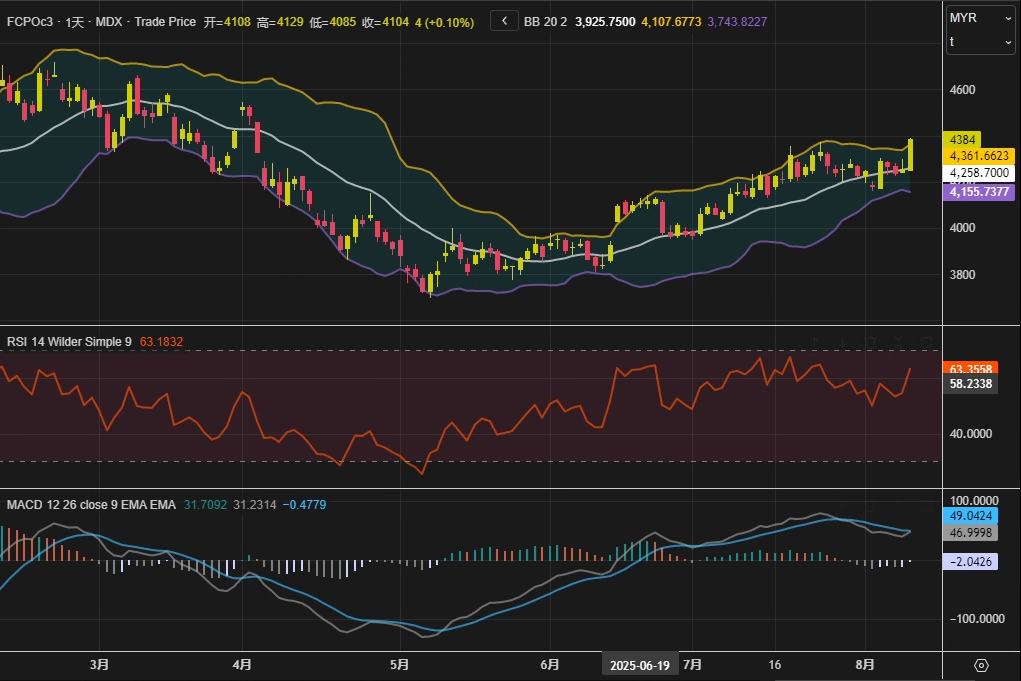Palm oil surges 3% in a single day: Technically, a "golden cross" is confirmed, but traders should be wary of this risk
2025-08-11 19:54:28

Inventory growth was lower than expected, while export data was strong.
Data released by the MPOB on Monday showed that Malaysia's palm oil inventories rose by 4.02% month-on-month to 2.11 million tons at the end of July, the highest level in nearly two years, but significantly lower than the market's expectation of a 5%-6% increase. Although production rebounded seasonally to 1.82 million tons (a month-on-month increase of 12.3%), exports were unexpectedly strong, increasing by 9.8% month-on-month to 1.42 million tons. More critical is the export data for the first 10 days of August: shipping survey agencies ITS and AmSpec recorded month-on-month increases of 23.3% and 23.7% respectively, far exceeding the historical levels for the same period. A trader in Kuala Lumpur pointed out: "There has been no panic accumulation of MPOB inventories, and the simultaneous rise in soybean oil and palm oil contracts on China's Dalian Commodity Exchange has further strengthened the bullish market sentiment."
Biodiesel policy and external market linkage
Eniya Listiani Dewi, a senior official at Indonesia's Ministry of Energy, confirmed on Monday that the B50 biodiesel program (increasing the palm oil blending ratio to 50%) will be implemented next year, but its launch may be delayed until after the first quarter. This statement eased market concerns about short-term supply pressures. Furthermore, external oil and fat markets saw a resurgence: soybean oil prices on the Chicago Board of Trade (CBOT) rose 1.68%, the main soybean oil contract on the Dalian Commodity Exchange rose 0.52%, and palm oil contracts surged 2.29%. Notably, the ringgit rose slightly by 0.09% against the US dollar. While this put slight pressure on import costs, it failed to offset the positive fundamentals.
Institutional Views: Finding Balance Amidst Differences
Some analysts are cautious about the sustainability of the current upward trend. The head of agricultural product research at a well-known institution noted, "Inventories remain high in absolute terms in July, and India's seasonal purchasing peak has not yet fully begun. If export growth fails to maintain in August, prices may face downward pressure." However, more market participants tend to be bullish. A trader at a commodities hedge fund in Singapore stated, "Frequent weather disturbances in Southeast Asian production areas, coupled with the long-term demand growth brought about by the B50 policy, are expected to gradually increase the central price of palm oil."
Market Outlook
In the short term, market sentiment has been ignited, with technical breakthroughs and improving fundamentals synergizing. However, two key points warrant attention: First, August typically sees a seasonal production peak; if export growth slows, inventory pressures could re-emerge; second, the potential impact of US dollar fluctuations on the ringgit exchange rate at a macro level. In the medium to long term, the progress of biodiesel policy implementation and the potential impact of El Niño on production in 2026 will be the driving factors. Investors are advised to closely monitor the MPOB monthly report and shipping data to verify the sustainability of the current rally.

- Risk Warning and Disclaimer
- The market involves risk, and trading may not be suitable for all investors. This article is for reference only and does not constitute personal investment advice, nor does it take into account certain users’ specific investment objectives, financial situation, or other needs. Any investment decisions made based on this information are at your own risk.





















